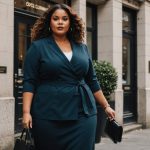Practical Techniques for Tailoring Oversized Blazers
Tailoring an oversized blazer to achieve a stylish appearance requires specific tools and techniques. Essential tools include a seam ripper, measuring tape, pins, and a sewing machine. These tools help execute precise fit modifications.
Resizing Sleeves and Shoulders
A key step in tailoring oversized blazers is adjusting the sleeves and shoulders. Begin by removing the blazer’s sleeves with the seam ripper. This allows easy access to the shoulder seams. Adjust the shoulder seam to reduce excess fabric. Be cautious not to compromise the blazer’s structural integrity. Once shoulders are adjusted, refit the sleeves, ensuring they align with the modified shoulder fit.
Also read : Choosing the Ideal Compression Wear for Maximum Post-Exercise Recovery: An In-Depth Handbook
Adjusting Length While Preserving Style
Length adjustment is another core aspect. Hemming is suitable for updating the blazer’s overall length. Pin the desired length before cutting to avoid mistakes. When shortening, use a narrow hem to maintain the blazer’s original style. For those wary of altering their garments extensively, consider professional tailoring services.
By focusing on these fit modifications, your oversized blazer will not only fit better but also remain a staple in your wardrobe. Remember, your goal is to modify the blazer to enhance your personal style while preserving its original character.
Also to see : Unlock the Secret to Perfect Handbag Pairing: Choose the Ideal Shape and Style for Every Wardrobe
Maintaining Style While Altering Fit
Tailoring an oversized blazer without losing its fashionable silhouette is an art. It’s crucial to balance structure and comfort. While modifying, ensure that the blazer retains its shape, offering both style and ease of movement.
Balancing Structure and Comfort
To preserve the blazer’s stylish appearance during fit modification, consider the fabric. Opt for materials that provide both flexibility and form. A well-structured blazer complements your body shape without restricting movement, allowing you to wear it comfortably on various occasions.
Incorporating Fashion Accessories
Accessories can significantly enhance your overall look while tailoring an oversized blazer. A sleek belt can define your waist, giving the blazer a more tailored fit. Statement jewellery or a classic watch can add flair without overwhelming the outfit, ensuring the blazer remains the focal point.
Experimenting with Layering
Layering techniques can also refresh your blazer’s style. Try combining it with a turtleneck for colder seasons or a light blouse in warmer weather. Layering not only adds depth but can also enhance the blazer’s fit by filling any remaining room, ensuring it fits snugly but stylishly. By focusing on these strategies, you can maintain a polished appearance.
Choosing the Right Colour for Your Mood
Understanding the impact of colour psychology can significantly influence your wardrobe selections. Each shade can evoke specific emotions and even alter your mood. By recognising these effects, you can tailor your clothing choices to enhance your day-to-day experiences.
Understanding Colour Psychology
Colour psychology delves into how colours affect feelings and behaviours. For instance, blue often inspires calmness and reliability, while yellow can uplift, promoting joy and optimism. When choosing colours for your wardrobe, consider how you wish to feel and be perceived. The right colour can be a subtle yet powerful tool, helping you navigate various social settings and personal moments with confidence.
Colours that Boost Confidence
Certain colours are known to instil confidence. Red, for instance, is bold and commands attention, often associated with power and passion. Meanwhile, black conveys elegance and authority. Incorporating these hues into your clothing can increase your assertiveness in professional and social contexts. Choose mood enhancing colours that reflect your personal style while boosting your self-assurance.
Selecting Colours for Versatile Outfits
Creating a versatile wardrobe involves selecting colours that can be effortlessly mixed and matched. Neutrals like beige, grey, and navy offer flexibility, enabling various combinations. By focusing on these colours, you can assemble outfits that effortlessly transition across different occasions while consistently presenting a cohesive, stylish appearance.











